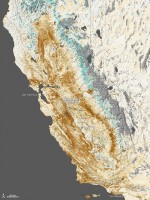Thursday, February 27th, 2014
As technology has improved, so has our understanding of the environment. For example, satellite imagery and other remote sensing techniques can quickly show us that forest cover is increasing in Europe. But in order to capture the complexity of ecological conditions and dynamics on the ground, it is essential to also use field-based surveying methods.

Sunday, February 23rd, 2014
Persistent dry weather has grown more worrisome in the American West, with nearly two thirds of the region experiencing some level of drought. By most measures, the state of California is suffering through the worst of it. The effects of the dry spell are visible in the mountains, where snow pack is lacking, and now
Monday, February 3rd, 2014
Ice in northern Alaska’s lakes during winter months is on the decline. Twenty years of satellite radar imagery show how changes in our climate are affecting high-latitude environments. Changes in air temperature and winter precipitation over the last five decades have affected the timing, duration and thickness of the ice cover on lakes in the
Monday, February 3rd, 2014
Oil and gas company Total has confirmed that it will not carry out extractive operations within natural World Heritage sites, including Virunga National Park. IUCN welcomes this decision and calls on all oil and gas companies to follow suit.
Sunday, January 26th, 2014
With the Copernicus environmental monitoring programme’s first satellite nearing launch, Portugal explores how best to exploit this initiative’s critical information. In order to stimulate the use of satellite-derived data within public administration, Portugal has created the Working Group for Earth Observation (GTOT). The group’s main focus is on information from Copernicus, including data from the
Tuesday, January 21st, 2014
Near the centre of Antarctica, measurements from CryoSat show an unusual pattern in the ice sheet’s elevation. Scientists have now found the reason for this pattern – and the discovery is leading to even more accurate measurements from ESA’s ice mission.
Thursday, January 16th, 2014
When a crisis develops, what sort of governance is best? Crises have traditionally resulted from situations of social turmoil, such as military invasion, revolution, or corruption, but expectations are that modern-day emergencies are more likely to arise from disturbances due to climate change and other environmental disruptions. Rising sea levels and severe weather patterns are
Monday, December 16th, 2013
Measurements from ESA’s CryoSat satellite show that the volume of Arctic sea ice has significantly increased this autumn. The volume of ice measured this autumn is about 50% higher compared to last year.
Sunday, December 15th, 2013
With the first of the Sentinel satellites being readied for launch next spring, scientists are looking ahead to the third mission in the series to ensure the highest quality data possible. The main objectives of the Sentinel-3 mission are to measure sea-surface topography, sea- and land-surface temperature and ocean- and land-surface colour.
Friday, December 13th, 2013
Three years of observations by ESA’s CryoSat satellite show that the West Antarctic Ice Sheet is losing over 150 cubic kilometres of ice each year – considerably more than when last surveyed. The imbalance in West Antarctica continues to be dominated by ice losses from glaciers flowing into the Amundsen Sea.